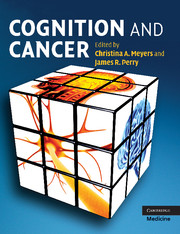Book contents
- Frontmatter
- Contents
- List of contributors
- Preface
- Section 1 Cognition and the brain: measurement, tools, and interpretation
- 1 Introduction
- 2 Clinical neuropsychology
- 3 Brain imaging investigation of chemotherapy-induced neurocognitive changes
- 4 Role of neuropsychological assessment in cancer patients
- 5 Neuropsychological assessment of adults with cancer
- 6 Neuropsychological assessment of children with cancer
- Section 2 Effects of cancer and cancer treatment on cognition
- Section 3 Interventions and implications for clinical trials
- Index
- Plate section
- References
4 - Role of neuropsychological assessment in cancer patients
Published online by Cambridge University Press: 13 August 2009
- Frontmatter
- Contents
- List of contributors
- Preface
- Section 1 Cognition and the brain: measurement, tools, and interpretation
- 1 Introduction
- 2 Clinical neuropsychology
- 3 Brain imaging investigation of chemotherapy-induced neurocognitive changes
- 4 Role of neuropsychological assessment in cancer patients
- 5 Neuropsychological assessment of adults with cancer
- 6 Neuropsychological assessment of children with cancer
- Section 2 Effects of cancer and cancer treatment on cognition
- Section 3 Interventions and implications for clinical trials
- Index
- Plate section
- References
Summary
Neurocognitive function is a very important issue in cancer survivorship. When present, neurocognitive deficits explain the lion's share of cancer survivors' reported decreased quality of life. However, scientific study of the neuropsychological sequelae of cancer is just beginning to be undertaken. A Medline search for 1996–2006 of “neuropsychology or neurocognitive” and “cancer” results in only 86 articles. Once those are selected to include only those that include information on cancer in adults (as opposed to pediatric cancer or adult survivors of pediatric cancers), written in English, only 34 papers remain. However, the relative paucity of research is in contrast to the recent attention given to this important topic, most recently in the Institute of Medicine Report From Cancer Patient to Cancer Survivor, in which cognitive dysfunction is listed as one of the important concerns of cancer survivors after treatment (Hewitt et al., 2006).
Neurocognitive deficits in cancer patients are variable. When patients report having neuropsychological impairments, they may note them as being very minor (e.g., “I'm in a fog” or “I have a lot of ‘senior moments’”) or patients may have significant neurocognitive deficits that impair their ability to speak, remember, or act appropriately. Some patients are not aware of their own deficits and only caregivers have noticed the changes. A cancer patient with neurocognitive dysfunction may decline during some periods, such as during active treatment, and improve during inter-treatment intervals; however, often the opposite pattern can be seen.
- Type
- Chapter
- Information
- Cognition and Cancer , pp. 33 - 43Publisher: Cambridge University PressPrint publication year: 2008
References
- 3
- Cited by



